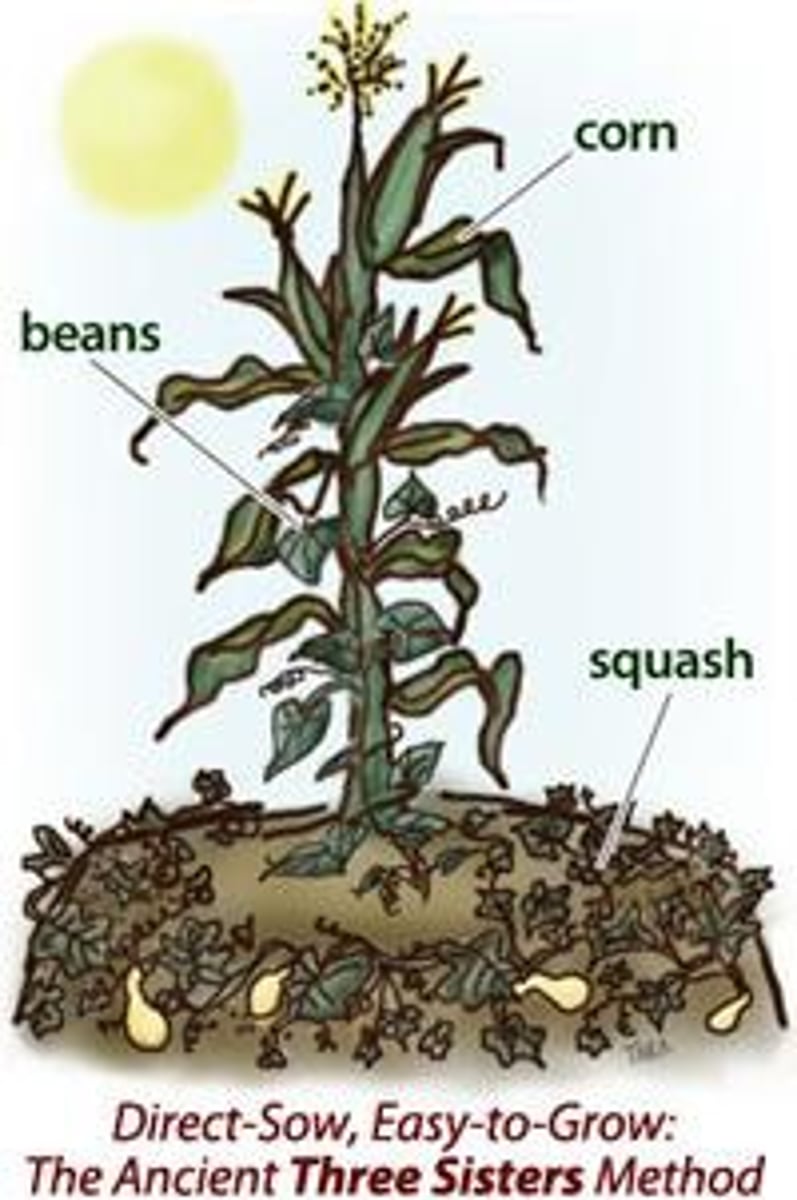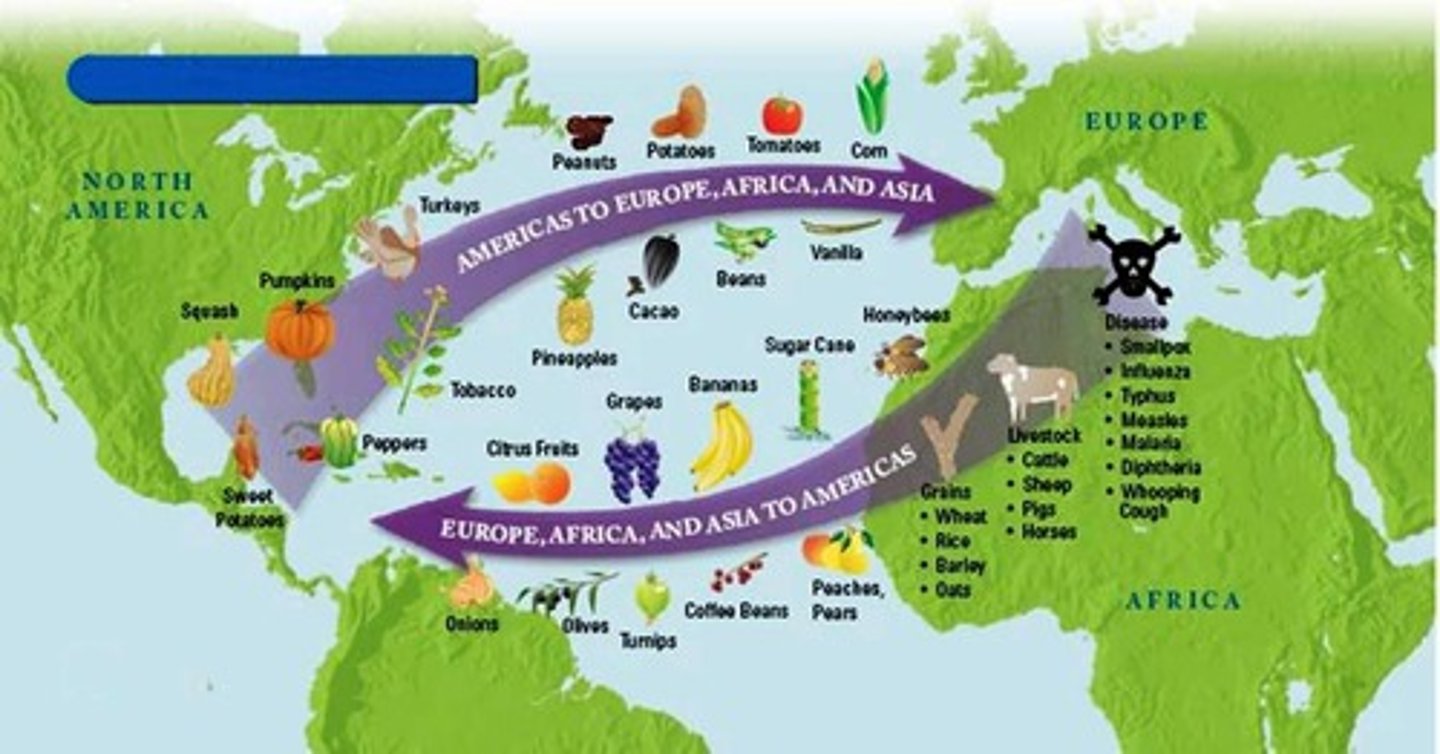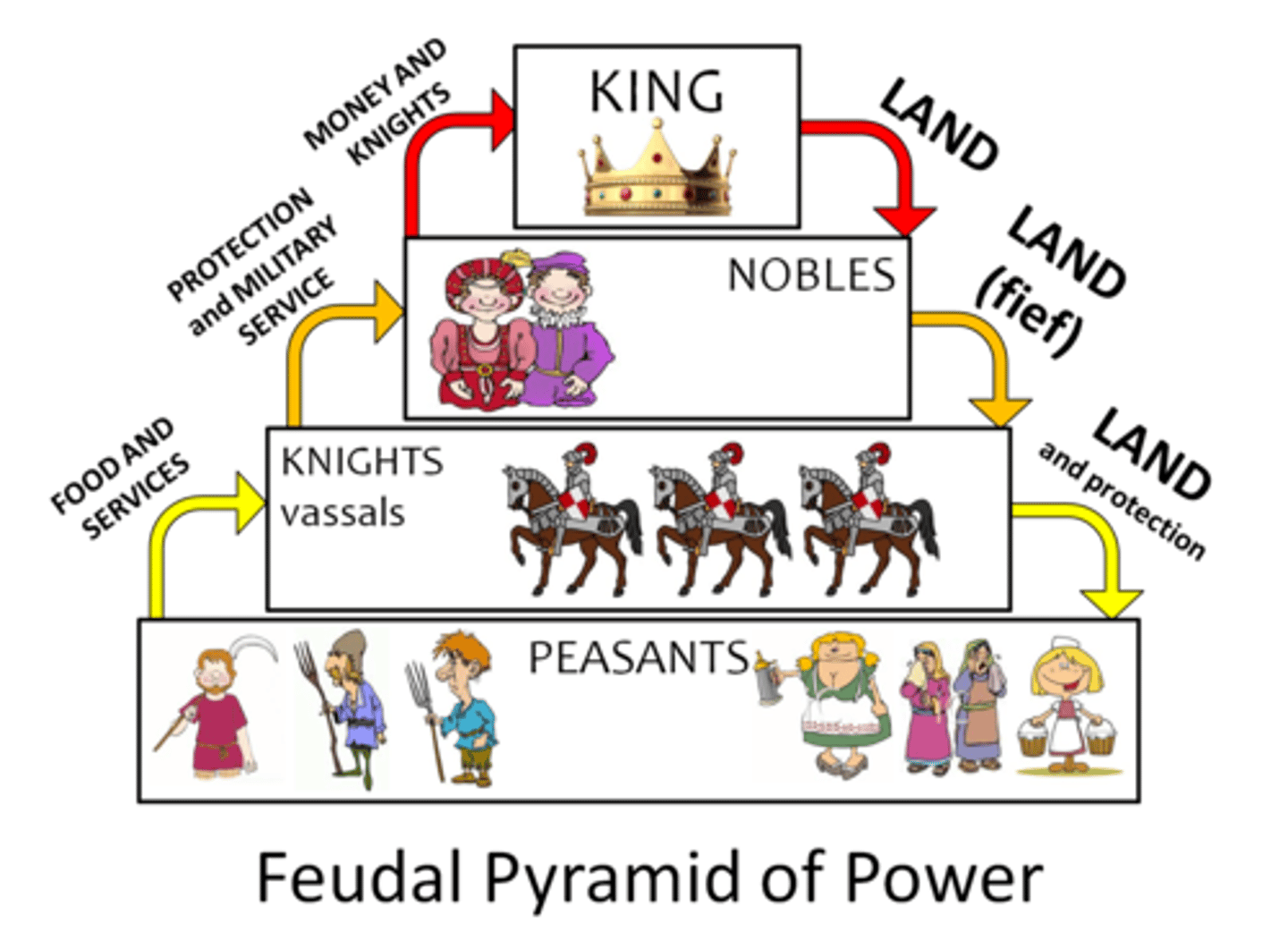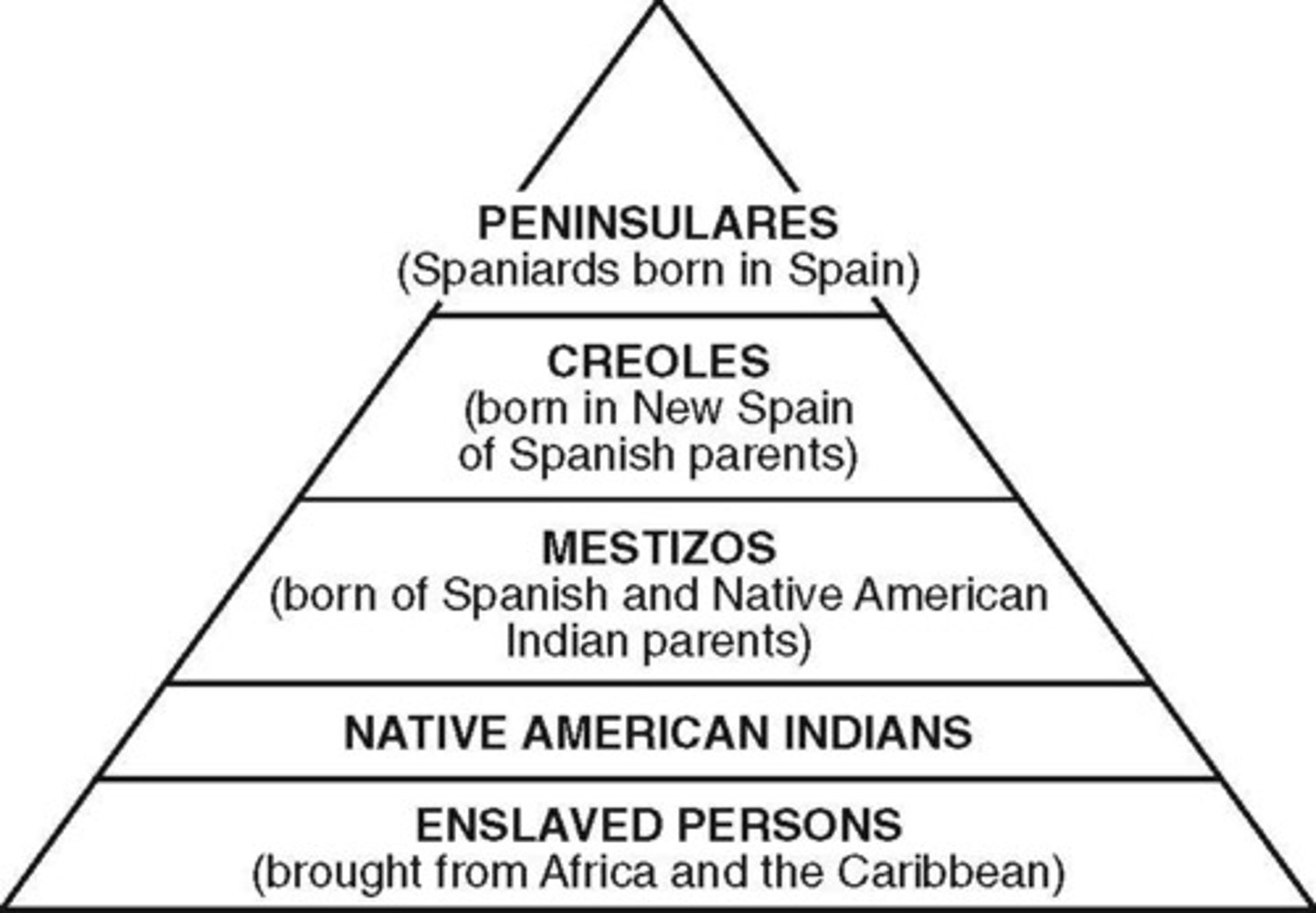APUSH: Period 1 (1491-1607) & Period 2 (1607-1754)
1/50
There's no tags or description
Looks like no tags are added yet.
Name | Mastery | Learn | Test | Matching | Spaced |
|---|
No study sessions yet.
51 Terms
Native American Culture (Prior to Colonization)
Year(s): Before 1491
Summary: Native groups adapted to their environments with regional innovations like irrigation (Pueblos), mound building (Mississippians), and nomadic bison hunting (Great Plains).
Significance: Demonstrated that Native societies were diverse, complex, and well-adapted before European contact.
The Three Sisters
Year(s): Before 1491
Summary: Corn, beans, and squash
Significance: Supported population growth, permanent settlements, and social development in Native cultures.

The Columbian Exchange
Year(s): Began in 1492
Summary: Exchange of crops, animals, people, and diseases between the Old and New Worlds.
Significance: Devastated Native populations through disease; introduced new foods and wealth to Europe, fueling population growth and capitalism.

Age of Exploration
Year(s): 1490s-1600s Summary:
Discovery of new lands led to wealth accumulation, scientific advances, and spread of Christianity.
Significance: Stimulated European economic, political, and cultural shifts toward exploration, colonization, and imperialism.
Feudalism
Feudalism was a hierarchical social, political, and economic system prevalent in medieval Europe

European shift from feudalism to capitalism
Year(s): 1500s Summary:
Wealth from colonies and trade encouraged private investment and profit-based economies.
Significance: Helped break down feudal land systems and promoted the rise of a market economy and merchant class.
Joint-Stock Companies
Year(s): 1500s-1600s
Summary: Businesses in which investors pooled money to fund colonies and share profits and risks.
Significance: Enabled European powers to fund colonization with reduced risk, leading to expansion in the Americas.
New Spain
Year(s): 1500s Summary:
A Spanish colonial empire built on wealth from silver/gold, Catholic missions, and rigid class structures.
Significance: Established long-lasting Spanish influence in the Americas and modeled future colonial systems.
Warfare
Year(s): Throughout 1500s
Summary: Spanish often used military force to subjugate Native populations (e.g., conquest of Aztecs, Inca).
Significance: Led to rapid European dominance and destruction of Native civilizations and power structures.
Deadly Epidemics
Year(s): 1492-1607 Summary:
Diseases like smallpox brought by Europeans wiped out 50-90% of some Native populations.
Significance: Weakened resistance to colonization and transformed demographic and cultural landscapes.
Encomienda System
Year(s): Established in 1503
Summary: Spanish labor system where colonists received land and Native labor in return for Christianizing them.
Significance: Enabled exploitation of Native peoples; laid foundations for forced labor systems and slavery.
Spanish Caste System
Year(s): 1500s
Summary: Racial hierarchy in New Spain based on bloodlines (Spanish > mixed > Native/African).
Significance: Institutionalized inequality and justified social control and resource distribution.

West African Slave Trade
Year(s): Began in 1500s Summary:
Europeans partnered with African leaders to trade goods for enslaved people.
Significance: Fueled transatlantic slavery; millions of Africans were forcibly transported to the Americas.
Trade Impact
Year(s): 1490s-1600s
Summary: New trade routes and goods
Significance: Created a global commercial network and increased wealth and competition in Europe.
Diplomatic negotiations
Year(s): 1500s
Summary: Some Native groups formed alliances or treaties with European powers for trade or protection.
Significance: Showed Native agency; temporarily helped some tribes preserve autonomy or gain advantages.
Military Resistance of Native Peoples
Year(s): 1490s-1600s
Summary: Native peoples resisted colonization through armed conflict
Significance: Delayed or challenged European domination, proving Native resilience.
The "Black Legend"
Year(s): 1500s
Summary: Anti-Spanish propaganda claiming Spain was uniquely brutal to Native peoples.
Significance: Used by rivals (like England) to justify their own colonization efforts as more humane.
Las Casas vs. Sepúlveda
Year(s): 1550-1551
Summary: Las Casas argued for Native rights; Sepúlveda defended conquest and enslavement.
Significance: Early debate over human rights and racial superiority in colonial policy.
Spanish migration and colonization
Year: 1600s-1700s
Summary: Spanish established missions, used forced Native labor, and built a caste system to manage colonial society.
Significance: Introduced European control, religion, and exploitation into Native lands, particularly in the Southwest.
French migration and colonization
Year: 1608-1763
Summary: France created trading posts and built alliances with Native tribes, especially through the fur trade, and intermarriage.
Significance: Led to relatively peaceful Native relations and slowed British westward expansion.
Dutch migration and colonization
Dutch Colonization Year: 1609-1664
Summary: The Dutch founded New Netherland to expand trade and welcomed religious and cultural diversity.
Significance: Created early centers of trade and tolerance, but lost land to the British by 1664.
British migration and colonization
Year: 1607-1754
Summary: British settlers came to establish permanent communities focused on agriculture, trade, and religion.
Significance: Their expansion led to land disputes with Native peoples and eventually to the founding of the United States.
Virginia (Jamestown)
Year: 1607
Founder: Virginia Company (Joint-stock company)
Purpose: Economic gain through gold and later tobacco farming
Massachusetts (Plymouth & Massachusetts Bay)
Year: 1620 (Plymouth), 1630 (Massachusetts Bay)
Founder: Pilgrims (Separatists, Plymouth), Puritans (Massachusetts Bay)
Purpose: Religious freedom for English Protestants
New Hampshire
Year: 1623
Founder: John Mason and settlers from Massachusetts
Purpose: Trade, fishing, and some religious freedom
Maryland
Year: 1632
Founder: Lord Baltimore (Cecilius Calvert)
Purpose: Safe haven for English Catholics.
Connecticut (Hartford)
Year: 1636
Founder: Thomas Hooker and Puritan dissenters from Massachusetts
Purpose: Religious freedom and better political structure
Rhode Island (Providence)
Year: 1636
Founder: Roger Williams
Purpose: Religious freedom (ie. Anne Hutchinson) and separation of church and state
Delaware (New Sweden)
Year: 1638
Founder: Swedish settlers; later taken by the English
Purpose: Trade and farming
North Carolina (Albemarle)
Year: 1653
Founder: Settlers from Virginia; chartered by King Charles II
Purpose: Farming and trade
South Carolina (Charles Town)
Year: 1670
Founder: Eight English nobles (Lords Proprietors)
Purpose: Agriculture and trade, especially rice and indigo
New York (New Amsterdam)
Year: 1664
Founder: Originally Dutch (New Netherland); taken by the English
Purpose: Trade and military strategy
New Jersey
Year: 1664
Founder: Lord Berkeley and Sir George Carteret
Purpose: Land grants and religious freedom
Pennsylvania (Philadelphia)
Year: 1681
Founder: William Penn
Purpose: Safe haven for Quakers and religious freedom, model of religious tolerance
Georgia (Savannah)
Year: 1732
Founder: James Oglethorpe
Purpose: Buffer colony against Spanish Florida; refuge for debtors
Mercantilism
Year: 1600s-1700s
Summary: Mercantilist policies required colonies to provide raw materials and buy finished goods from England.
Significance: Caused growing resentment in the colonies and laid economic foundations for revolution.
Chesapeake Colonies
Year: 1607-1700s
Summary: Virginia and Maryland grew wealthy through tobacco farming, initially using indentured servants.
Significance: Their reliance on labor set the stage for widespread adoption of African slavery.
Middle Colonies
Year: 1660s-1700s
Summary: Colonies like New York and Pennsylvania featured religious freedom, ethnic diversity, and mixed economies.
Significance: Became cultural melting pots and models for democratic governance.
Colonial Self-Government
Summary: Colonies developed representative assemblies.
-House of Burgesses: the first democratically elected legislative assembly in the British American colonies
-Mayflower Compact: An attempt to establish a temporary, legally-binding form of self-government in Plymouth
Significance: Fostered political independence and later resistance to British rule.
Commercial Transatlantic Exchanges; Triangular Trade
Year: 1600s-1700s
Summary: Trade routes connected Europe, Africa, and the Americas through goods, slaves, and raw materials.
Religious Transatlantic Exchanges
Year: 1600s-1700s
Summary: Protestant religious ideas and revivalism moved between Europe and the colonies.
Significance: Inspired movements like the Great Awakening and increased religious pluralism.
Philosophical Transatlantic Exchanges
Philosophical Transatlantic Exchanges Year: 1700s
Summary: Enlightenment ideas emphasized reason, liberty, and individual rights.
Significance: Influenced colonial leaders and encouraged demands for political change.
Powhatan Wars
Year: 1610-1646
Summary: A series of wars in Virginia between English settlers and Powhatan tribes.
Significance: Ended with Native defeat and solidified English control in the region.
Metacom's (King Philip's) War
Year: 1675-1676 Summary: Major war between New England Natives and colonists over land and sovereignty.
Significance: Destroyed Native power in the Northeast and expanded English territory.
Pueblo Revolt
Year: 1680
Summary: Pueblo Indians in New Mexico rose against Spanish rule and temporarily drove them out.
Significance: One of the most successful Native uprisings; led to more tolerant Spanish policies.
Great Awakening
Year: 1730s-1740s
Summary: A Protestant religious revival that emphasized personal faith and emotional sermons.
Significance: Unified the colonies spiritually and encouraged individual thought and equality. Think preachers as George Whitefield and Jonathan Edwards.
Enlightenment Era
Year: 1700s
Summary: A movement focused on logic, liberty, and scientific reasoning (Locke, Montesquieu).
Significance: Inspired colonial leaders and shaped revolutionary ideology.
Anglicization
Year 1607-1754
Summary: Colonists adopted English customs, government structures, and consumer habits.
Significance: Strengthened colonial ties to Britain, but also led to expectations of equal rights.
Bacon's Rebellion
Year: 1676
Summary: Poor farmers in Virginia rebelled against colonial elites and Native policies.
Significance: Exposed class tensions and encouraged a shift toward African slavery.
Indentured Servitude vs. Chattel Slavery
Year: 1607-1700s
Summary: Indentured servants worked temporarily, while enslaved Africans were property for life.
Significance: Shift to slavery provided permanent labor and entrenched racial hierarchies.
African Resistance to Slavery
Year: 1607-1754
Summary: Enslaved Africans resisted through rebellion, escape, work slowdowns, and cultural preservation.
Significance: Showed African resilience and influenced early African-American culture and identity.